
|
Warning!
At least some content in this article is derived from information featured in Harry Potter: Hogwarts Mystery. Spoilers will be present within the article. |
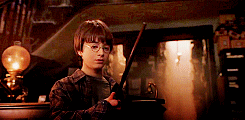
Harry Potter's wand choosing him
- "You talk about wands like they’ve got feelings... like they can think for themselves."
- — Harry Potter to Mr Ollivander[src]
Wandlore is an ancient, complex, and mysterious branch of magic dealing with the history, abilities, and actions of wands, quasi-sentient magical tools used by wizards and witches to cast spells. This particular branch of magic is carefully studied by wandmakers such as Garrick Ollivander and Mykew Gregorovitch.
The history of wandlore was covered in sixth year History of Magic classes at Hogwarts in the 1989-1990 school year.[1]
The study of wandlore
Origins
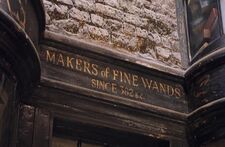
A sign outside of Ollivanders
Wandlore may have been explored first by ancient wizards more than two thousand years ago. This can be deduced from the peeling sign outside of Ollivanders which reads "Ollivanders: Makers of Fine Wands Since 382 B.C."[2] In the beginning of wizarding history, the magical forces of the wand may have been experimented upon and explored through the ages, with all its findings written down, as with many other mysteries of the world, each with its dedicated and brilliant explorers. And like those fields, it was further comprehended as time went on.
Study of the lore
After magical education, a person seeking to become a wandmaker must become the apprentice of a skilled wandmaker. From there, they may undergo the study of wandlore. There is also a possibility that there are gatherings where wandlore lessons are taught. Even so, it is clear that wandlore must be understood clearly in order to become a skilled wandmaker.
Complexity
Mr Ollivander revealed to Harry Potter in 1998 that wandlore was "complex and mysterious"; even the most skilled did not fully comprehend it. Ollivander himself confessed that he did not fully understand Priori Incantatem, a reaction between two wands with cores from the same source, or why Harry's wand destroyed the wand of Lucius Malfoy when Harry faced Lord Voldemort during the Battle of the Seven Potters.[3]
Wands choose the wizard or witch in a way that is neither random, nor serendipitous. There is much ancient mythology and botanical knowledge regarding the powers and natures of wood and other natural elements.
Harry Potter and Voldemort's wands

Harry Potter's wand was made of holly, with a phoenix feather core.[2] In numerous ancient and modern historical references, the holly tree, an evergreen, represents life and was deemed a guardian and protector against poison, lightning, and witchcraft. The phoenix feather represents a renewal of life, which Harry accomplished on more than one occasion when others thought he should be dead. His wand wood is also the same as his birth month's wood in the Celtic calendar, which associated holly with courage and a battle between kings.[4]
In contrast, Voldemort's wand was yew and phoenix feather. Yew is associated with some of the oldest legends of Great Britain, for it was revered by the Druids. It is poisonous and is known to kill cattle. The phoenix feather may represent Voldemort's obsession with preserving his own life; he created Horcruxes so that he may be reborn each time he is killed.
Other examples
- Draco Malfoy's wand is made of hawthorn. According to botanical and historical references, hawthorn flowers have the smell of death or decomposing meat, and are fertilised by carrion insects. Hawthorn is also Draco's Celtic birth month wood.
- Hermione Granger's wand is made from vine wood, which is the wood attributed to her birth month on the Celtic calendar. The Celts associated vine with the autumn equinox, and with looking inward.
- Ron Weasley's wand of ash also corresponds to his birth month on the Celtic calendar, which associated ash with balance.[4]
- The Elder Wand is made of elder. From ancient tradition, elder is the emblem of sorrow and death. Some of the mythology surrounding elder assigns it the power to drive away evil spirits and protect against witches. In the Celtic calendar, the Elder Moon contains the darkest days of the year and was associated with death and regeneration, transformation, and the underworld.[4]
Other properties of wands can also reveal aspects of their owners' characters. For example, Ollivander described Bellatrix Lestrange's wand as "unyielding", Peter Pettigrew's wand as "brittle"[3] and Draco Malfoy's wand as "reasonably pliant". Another example is the length of the wand; Rubeus Hagrid's wand is one of the longest noted wand, at 16". It is representative of his half-giant blood, and Dolores Umbridge's wand is particularly short, as she was described.
Certain wands can also be predisposed to skill at a particular magical discipline. For instance, the wand of James Potter was particularly good for Transfiguration.[2] This may be due to the various flexibilities of the wand, which accommodate different wand motions.
Wandcraft
Through wandlore, a future wandmaker learns the ancient secrets of creating a wand, each having four components:
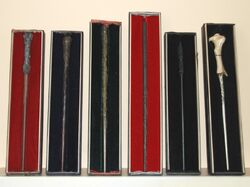
Various wands
Wand wood
Bowtruckles, tree-guardians, opt to live in wand-trees whose wood is of wand quality - wand wood. Therefore, it can be assumed that one can not simply walk into a forest, retrieve a twig, and create a wand. Wand woods may already be magical or merely be the only kinds of wood strong enough to sustain the power of magic within.[5]
Magical cores
Wands contain magical cores, possibly magically inserted once the wand has been carved. These magical cores enhance the wand magic or give the wand wood magical abilities. The only cores able to produce magic are from magical species. Mr Ollivander opts to only use phoenix feathers, unicorn hairs, and dragon heartstrings, which may be the most powerful and best of magical cores, as Ollivander's wands have been praised by many witches and wizards from around the world. Other materials, such as Veela hair, or even Thestral hair, have also been used by other wandmakers.
Wand length
All wands have their individual lengths and may also be some correlation between a person's size and the lengths of their wands. Rubeus Hagrid, who is half-giant, owned one of the longest known wand; it was sixteen inches long and made of oak. It was snapped in half after he was blamed for the opening of the Chamber of Secrets. The shortest known wand once belonged to Dolores Umbridge, who is described as being squat and toad-like. Her "unusually short" and stubby wand was dropped in the Forbidden Forest and snapped in half by a centaur's hoof.
According to Garrick Ollivander, matching a wand to a wizard solely by height is a crude measure. Long wands tend to suit those with big personalities, of a more spacious and dramatic style of magic. Neater wands favour elegant and refined spell-casting. Particularly short wands will choose wizards whose character lacks something[6], as is exemplified by Hagrid's wand's extreme length being attributable to his exciteable, outgoing, and energetic personality, while Umbridge was known for her extreme bigotry and lacked empathy and was very cruel, yet stuck to politics and never sought power greater than what the law could grant her.
Flexibility
Usually, wands are only described in terms of the source tree, its core and its length. However, occasionally, the firmness of the wand wood has also been described. For example, on inspection of the wands of Harry Potter, Bellatrix Lestrange, Draco Malfoy and Rubeus Hagrid, Garrick Ollivander described them as "nice and supple", "unyielding", "reasonably springy", and "brittle", respectively. Rigidity or flexibility of a wand characterises the willingness to change and adapt of the wand-and-wizard pair.[6]
The creation of the Elder Wand
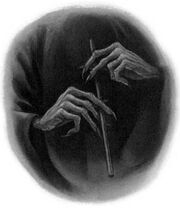
Lord Voldemort holding the Elder Wand.
The creation of the Deathly Hallow Elder Wand is highly unusual. In the book The Tales of Beedle the Bard, there is the legend of the Deathly Hallows called The Tale of the Three Brothers. In the story, Death is asked by the oldest of the Peverell brothers to be given a wand that would win duels. Death approaches an Elder tree, retrieves a branch, and creates the Elder Wand.
It is not said if this tree bore wand wood and likewise the nature of the core was never disclosed in the original tale. However, Albus Dumbledore and many others who chased after the Deathly Hallows believe that it was actually created by Antioch Peverell himself, instead of by Death. The wand is known to be made of Elder with a core of Thestral hair, both materials which have strong cultural connotations of death.[7]
Wand death and wilting
- "Wilting" of a wand occurs when the wand expels all magic, inhibiting its further magical use. This phenomenon most often occurs with hazel wands, which often bond so strongly with their true masters that after their owners' death those wands lose all magic in this way. This is curable by replacing the wand core, unless the core was originally of unicorn hair, in which case there is no hope and the wand will have actually "died" as opposed to simply wilted.[8]
Certain wands can wilt by other means. Salazar Slytherin's wand was commanded to wilt by Gormlaith Gaunt to prevent it from being used against her. She was able to do this due to the unique composition of the wand, and her gift of Parseltongue.
The subtle laws of wands
- "The wand chooses the wizard. That much has always been clear to those of us who have studied wandlore...if you are any wizard at all you will be able to channel your magic through almost any instrument. The best results, however, must always come where there is the strongest affinity between wizard and wand. These connections are complex. An initial attraction, and then a mutual quest for experience, the wand learning from the wizard, the wizard from the wand."
- — Mr Ollivander[src]
Wands possess a force of magic that itself has its own boundaries where none can go beyond. This is similar to Newton's laws of motion and other forces, and are known as the subtle laws of wands[9].
The fundamental laws
Mr Ollivander states that a wand chooses a wizard. It is not clear why, but certain wands seem to have a natural affinity for certain wizards or witches; this is the most fundamental law. The second states the connections made between both wizard and wand are complex, and will grow with experience, the wand learning from the wizard, the wizard from the wand. Thirdly, a wizard may channel his energy with any wand, whether his or not. However, the best results come where there is a great likeness between a wizard and a wand.

Lastly, a wand may be won from its master, and only then will its allegiance bend towards the new master. To win a wand, one must overpower and hence defeat its master in some way (this does not apply in situations such as practise duels, in which being disarmed or defeated will not affect a wand's loyalty). However, it should be noted that wands usually stay loyal to their original owners. For example, even if a wizard is disarmed or loses a fight while carrying his wand, the wand will have developed an affinity with its original owner so that it will not be given up easily. Therefore, simply disarming a wizard may not be enough to win over a wand's allegiance. The only exception to this is the Elder Wand, which is "completely unsentimental" and will only be loyal to strength. In other words, when won, it switches its allegiance entirely.[10] When a wand has not been won, it will not work as well for its new owner, as when Harry Potter was forced to use a blackthorn wand and when Hermione Granger used Bellatrix Lestrange's wand, neither of which they had won.[3] Therefore, it seems that any wand used against its own true owner will cause it to work lesser or cause the attempted spell to fail or backfire upon the user, similar to the Elder Wand.
- Hermione: "I hate that thing. I really hate it. It feels all wrong, it doesn’t work properly for me… It’s like a bit of her."
- Ron: "It’ll probably help you get in character, though. Think what that wand’s done!"
- Hermione: "But that’s my point! This is the wand that tortured Neville's mum and dad, and who knows how many other people? This is the wand that killed Sirius! I miss my wand."
- — Hermione on using Bellatrix Lestrange’s wand[src]
In some families, wands may be inherited, such as Neville Longbottom using his father's wand and Ron Weasley using his brother Charlie's old wand. However, each of these cases ended with the wands being snapped in half, and both Neville and Ron were more successful using other wands, therefore making it questionable that one can fully master a wand gained in this way. This is especially true in Neville's case, as his magical aptitude was almost non-existent before the loss of his father's wand during the Battle of the Department of Mysteries his fifth year, with him only being able to accomplish useful spells with tremendous effort and focus. During his sixth and seventh year, however, Neville's magical talents become evidently powerful with a wand that chose him. Therefore, it may have actually been his father's wand which suppressed his talents so much.
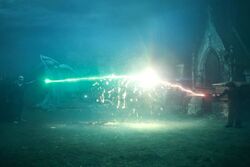
Priori Incantatem between Harry Potter and Voldemort in 1995
Priori Incantatem
Two wands with cores coming from the same magical creature, referred to as "brothers", cannot be forced to duel against one another. Should two such wands ever come in the way of one another, a rare connection is formed called Priori Incantatem. When the connection is formed, the wands battle to merge a golden orb into the other's shaft; the one that succeeds to force the orb in the other is the winning wand. Another case is that when two wands with the same source of their core are used alongside each other, their combined magical power will increase significantly to the benefit of their owners. Because of its rarity, most wizards never learn that such a connection is possible - this is the first law of Priori Incantatem.
After two brother wands connect through means of Priori Incantatem, both wands come to know one another and may react towards each other without the consent of their owners, or the winning wand only reacts towards the losing wand - this is the second law of Priori Incantatem[11]. Also, under special conditions, it is possible for one wand to recognise its "brother's" master, even when a different wand is used. For example, during the Battle of the Seven Potters, Harry's wand recognised Voldemort and spurted "golden flames" at him, even though Voldemort was using Lucius Malfoy's wand at the time.[3]
Damaged wands
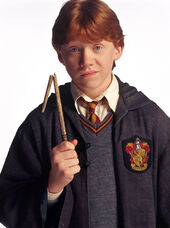
Ron Weasley with his broken wand
Wands that have suffered an immense degree of damage can not be fixed by any means most wandmakers know, except with help from the Elder Wand, as seen when Harry Potter's wand was broken from a reflected Blasting Curse and Hermione Granger was unable to repair it; Harry, however, fixed it with the aid of the Elder Wand.[3]
Accomplished wandmakers
- By the 1920s, there were four great and prominent wandmakers in the United States of America, all of whom had different methods and views on what it took to craft a good wand, but who all had ties with Ilvermorny School of Witchcraft and Wizardry, from whom the school sought expertise when the students were to be selected for a wand following the school's sorting ceremony. There were Shikoba Wolfe, a witch of Choctaw descent who were particularly well known for her intricately carved wands containing Thunderbird tail feathers, which were reputed to be extremely powerful, though difficult to master. Another accomplished soul in the craft of wandlore were Johannes Jonker, the son of non-magical parents who learned the art of working with wood from his father, who had been was an accomplished cabinet maker. Jonker made wands that were both instantly recognisable because most of them were inlaid with mother-of-pearls, and, more importantly, highly sought after. Thiago Quintana, on the other hand, preferred a sleek and oftentimes lengthy design or his wands, into which he would encase a single translucent spine from the back of the White River Monsters of Arkansas known to produce spells of force and elegance. Violetta Beauvais from New Orleans, on her part, made wands that always made of swamp mayhaw wood that contained hair of the rougarou, the dangerous dog-headed monster that prowled Louisiana swamps.
Two of the most accomplished European wandmakers were Garrick Ollivander and Mykew Gregorovitch. The former of the two was widely considered the best wandmaker in Britain, and, some would say, the whole wizarding world. Yet others maintained that Gregorovitch was even more skilful than his British counterpart.
Ollivander was kidnapped by Death Eaters for information on the connection between Harry Potter's wand and Voldemort's wand, but later escaped with the assistance of Dobby, while Gregorovitch was killed by Voldemort for not telling him who the thief of the Elder Wand was.[3] Ollivander also had an associate in Hogsmeade, who was learned in wandlore. It is unknown whether he also manufactured wands.
Apart from those, there were other lesser known wandmakers living and working in Britain, though not in the same vein as Ollivander, such as Jimmy Kiddell.
Behind the scenes
- Both the shortest wand (Dolores Umbridge's wand) and one of the longest wands (Rubeus Hagrid's wand) known in the series were snapped in half.
- In The Tales of Beedle the Bardcommentary, Albus Dumbledore mentions that he is knowledgeable in wandlore.
- In Harry Potter and the Deathly Hallows: Part 1, Voldemort appears to have some knowledge of wandlore, as he recognises Lucius Malfoy's wand as being made of elm without having to ask, as he does in the novel.
Appearances
- Harry Potter and the Deathly Hallows (Mentioned only)
- Harry Potter and the Deathly Hallows: Part 2 (Mentioned only)
- The Tales of Beedle the Bard (Mentioned only)
See also
Notes and references
- ↑ Harry Potter: Hogwarts Mystery, Year 6, Chapter 2 (Curses and Prophecies)
- ↑ 2.0 2.1 2.2 Harry Potter and the Philosopher's Stone
- ↑ 3.0 3.1 3.2 3.3 3.4 3.5 Harry Potter and the Deathly Hallows
- ↑ 4.0 4.1 4.2 The Celtic Tree Calendar
- ↑ Harry Potter and the Order of the Phoenix, Chapter 13 (Detention with Dolores)
- ↑ 6.0 6.1 Writing by J. K. Rowling: "Wand Lengths and Flexibility" at Wizarding World (archived from Pottermore)
- ↑ J.K. Rowling's site
- ↑ Writing by J. K. Rowling: "Wand Woods" at Wizarding World (archived from Pottermore)
- ↑ Harry Potter and the Deathly Hallows, Chapter 24 (The Wandmaker)
- ↑ PotterCast 131
- ↑ Harry Potter and the Goblet of Fire
